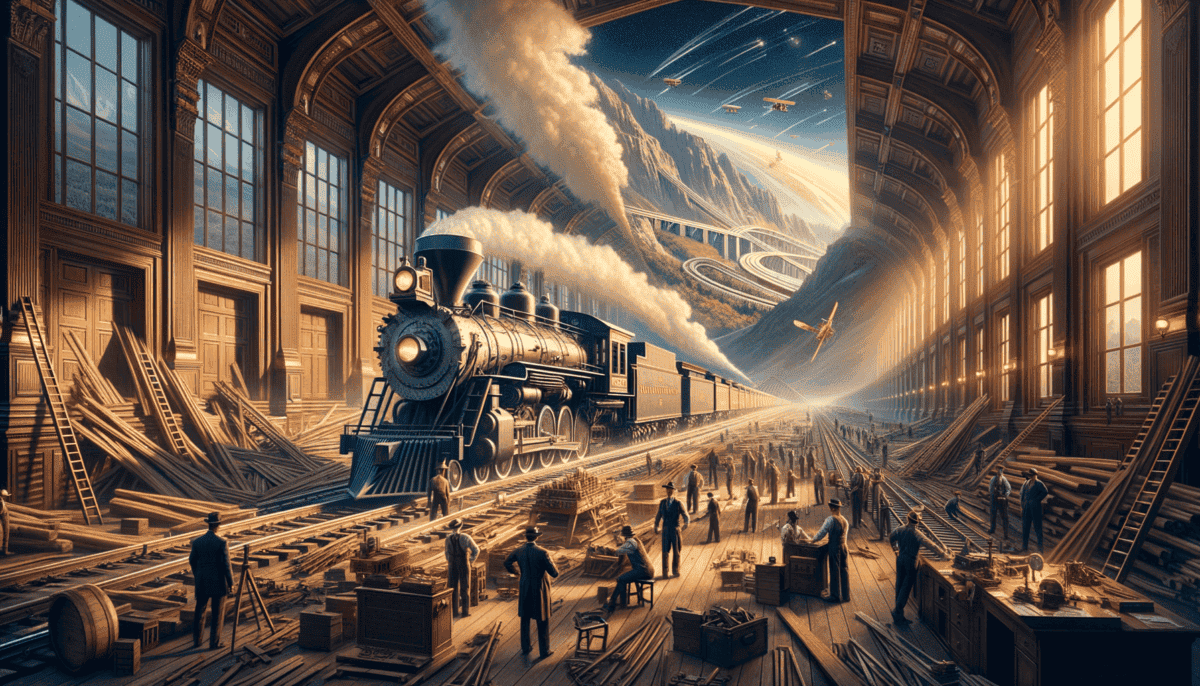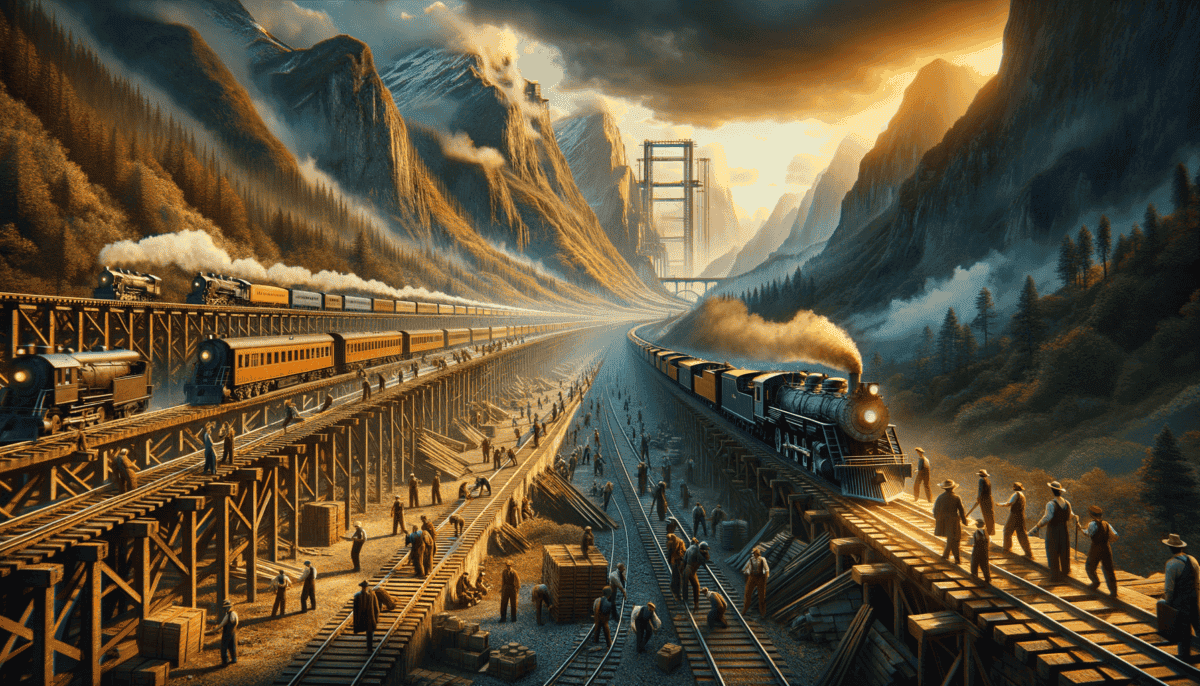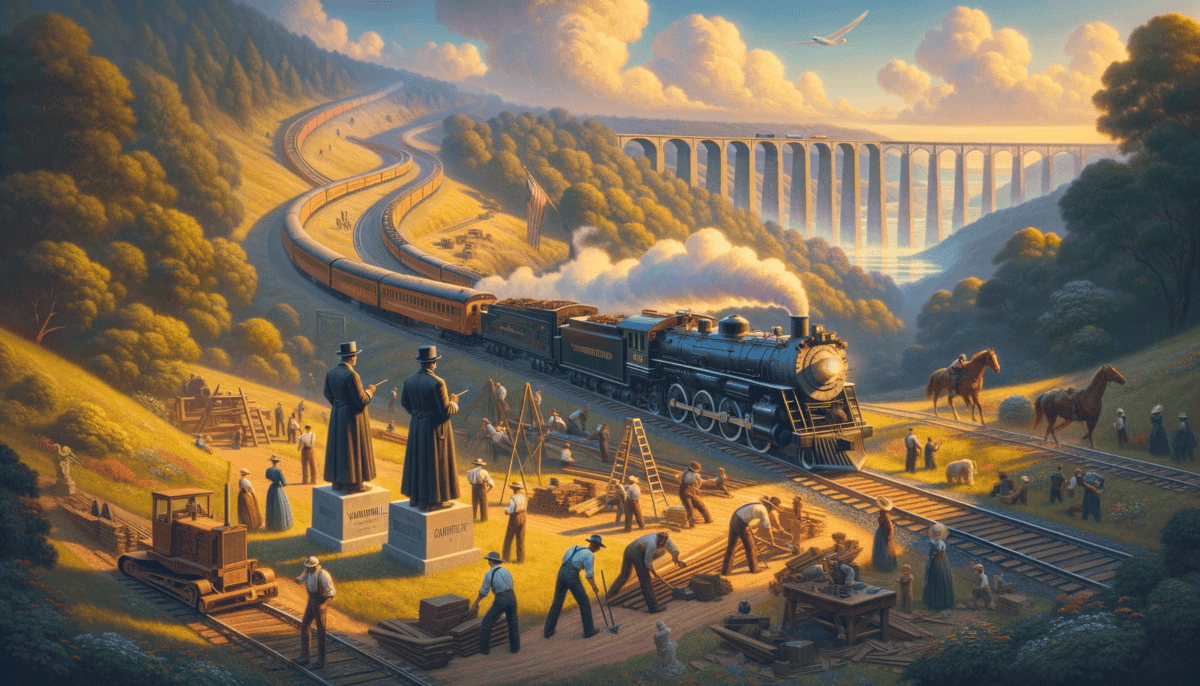A Vision of Iron and Steam
Tommy couldn't believe his eyes. The huge steam engine puffed black smoke into the blue sky. It was 1830, and he had never seen anything like it before.
"What is that, Pa?" Tommy asked, tugging on his father's sleeve.
His father smiled. "That's the future, son. They call it a locomotive. It's going to change everything."
A New Way to Travel
Back then, getting around America was very hard. People used horses and wagons to move things. It took weeks to go from one city to another. Sometimes the roads were so muddy that wagons would get stuck!
But some smart people had a big dream. They wanted to build something called railroads. These were special metal tracks that trains could run on. The trains would be much faster than horses.
The Big Dream
One of these dreamers was a man named Peter Cooper. He built a tiny train called the Tom Thumb. It wasn't very big – about the size of a pickup truck today. But it showed people what trains could do.
"It's impossible!" some people said. "You can't build tracks across the whole country!"
But Peter knew better. He said, "We can connect all of America with iron rails!"
Making it Happen
Building railroads was not easy. Workers had to:
• Cut down trees
• Move big rocks
• Build bridges
• Lay heavy metal rails
But the dream was too important to give up. More and more people started helping. They wanted to be part of this exciting new thing.
The First Steps
In Baltimore, people celebrated when the first real railroad started running. Children waved flags. Adults cheered. The train whistle echoed through the streets.
"This is just the beginning," Tommy's father said, watching the train roll by. "Soon there will be trains everywhere!"
He was right. This was the start of something huge. The railroad barons were coming – men who would build iron tracks across America. They would make the dream of connecting the whole country come true.
Tommy watched the train until it disappeared around a bend. He didn't know it yet, but he was seeing the start of one of the biggest changes in American history. The age of the railroad was beginning, and nothing would ever be the same.
The smoke from the locomotive drifted away on the wind. But the dream of connecting America by rail was just starting to grow. Big things were coming down the tracks.
Giants of the Railroad
The year was 1850, and three men stood looking at a map of America. They were Cornelius Vanderbilt, Leland Stanford, and Jay Gould. These men would become known as the Railroad Barons.
"We can build tracks from New York to California!" Vanderbilt said, his eyes shining with excitement.
The Commodore and His Trains
Cornelius Vanderbilt was nicknamed "The Commodore." He started with just one boat, but now he wanted to rule the railroads. He wore fancy suits and lived in a big house in New York.
The Race Begins
Each Railroad Baron wanted to build the biggest train company. They worked very hard to make their trains better and faster than everyone else's.
"My trains will be the fastest!" said Stanford.
"Mine will carry the most people!" Gould replied.
"We'll see about that," Vanderbilt smiled.
Building the Iron Roads
Making railroads was super hard work. The workers had to:
• Cut through mountains
• Build bridges over rivers
• Put down heavy metal rails
• Make sure the tracks were straight
Sometimes it was very dangerous. The workers were brave and strong. They worked in hot sun and cold snow to build the tracks.
The Big Race
Each Railroad Baron wanted their trains to go to new cities first. They rushed to build tracks faster than each other. Sometimes they would build right next to each other's tracks!
A worker asked Vanderbilt, "Why are you in such a hurry?"
"Because," he answered, "the first one to build the tracks gets to carry the people and their goods. And that means more money for our company!"
Changes Come to America
As the railroads grew, America changed too. Small towns got bigger. Farmers could send their food to far-away cities. People could travel to new places they had never seen before.
Big Dreams and Big Plans
The Railroad Barons kept dreaming bigger. They wanted their trains to go everywhere in America. Each one thought their company would be the biggest and best.
"This is just the start," Vanderbilt told his friends. "Soon our trains will connect every city in America!"
The race to build railroads was changing America forever. The Railroad Barons were making history with every mile of track they laid. And they were just getting started!
As the sun set, you could hear train whistles echoing across the land. The Iron Horse was running wild and free, and America would never be the same again.
Building Dreams of Steel
The sun rose over the dusty plains as hundreds of workers gathered. It was 1863, and the biggest project in America was about to begin: the Transcontinental Railroad!
Two Teams, One Big Goal
Two groups of workers started building from different places. The Central Pacific started in California, while the Union Pacific began in Nebraska.
The Brave Workers
Many Chinese workers helped build the railroad from the west. They were very brave and worked hard in dangerous places.
“Watch out for falling rocks!” Ming called to his friends as they dug through the mountains.
Irish workers built from the east. They worked through hot summers and cold winters.
New Ways to Build
The workers invented clever ways to build the railroad. They used:
• Special hammers for the spikes
• Big drills for the mountains
• Strong powder to break rocks
• New bridges that wouldn’t fall
Meeting the Natives
As the railroad moved west, the workers met Native American tribes. Some tribes were worried about the railroad crossing their land.
“This iron horse will scare away the buffalo,” a chief told the workers.
The railroad companies made deals with some tribes, but not all were happy. It was a hard time for the Native Americans.
Big Problems, Bigger Solutions
Building the railroad was super hard! The workers faced:
Snow deeper than a train wheel! ❄️
Rivers wider than 50 horses!
Hot days that made the rails too hot to touch! ️
But the workers didn’t give up. They found ways to solve every problem.
A New Way to Travel
“Look how far we’ve come!” said Mr. Stanford, pointing at the new tracks. “Soon people can ride from New York to California!”
The railroad would change how people lived. Now they could:
✨ Send letters faster
✨ Visit family far away
✨ Move to new places easily
✨ Ship food and things across America
The Golden Spike
The big day came in 1869. The two railroad teams met in Utah. They would connect their tracks with a special golden spike!
“This is a great day for America!” shouted the workers as the final spike went in.
The crowd cheered as the first train crossed the connected tracks. America was now joined from east to west by rails of steel.
The railroad workers had done something amazing. They had built a path of iron that would change America forever. As the sun set that day, the sound of train whistles filled the air with a song of victory.
Money, Power, and Steam
The railroad race was getting bigger and faster! Rich men called “Railroad Barons” wanted to control all the tracks. They fought like kings over their iron kingdoms.
The Battle of the Tracks
Cornelius Vanderbilt sat in his big office in New York. He looked at a map covered with railroad lines. “I want all the tracks in the East!” he said, pounding his desk.
Money Games
Jay Gould smiled as he bought more railroad shares. He was playing tricky money games to get more tracks.
“The more railroads we own, the more money we make!” he told his friends.
“They’ll have to join us or close down,” Gould replied.
Help from the Government
The government gave railroad companies special gifts:
• Free land along the tracks
• Money to build more rails
• Permission to charge what they wanted
• Special rules to help them grow
Towns Pop Up Like Magic
Everywhere the tracks went, new towns appeared! People moved to these “railroad towns” to work and live.
“Yesterday this was empty land,” said Sarah, looking at her new home. “Today it’s a whole town with stores and houses!”
The Price of Power
The Railroad Barons became very powerful. Sometimes they:
Made people pay too much for train rides
Built towns where they wanted
Controlled who could use the trains
Owned banks and other businesses
Fighting Back
Some people didn’t like how much power the Railroad Barons had. Farmers were angry about high prices.
“We can’t afford to send our crops on the trains!” complained farmer John. “The railroad prices are too high!”
Big Changes for America
Even with problems, the railroads changed America in amazing ways:
✨ Mail could travel across the country in days instead of months
✨ Fresh food could be sent far away
✨ People could visit new places easily
✨ Towns grew into big cities
The Growing Empire
“Our railroads are like giant metal rivers,” said Leland Stanford. “They carry America’s dreams from coast to coast.”
The Railroad Barons kept building more tracks. They connected more cities and towns. Their iron empires grew bigger every day.
As night fell over the railroad offices in New York, the Railroad Barons were still making plans. They dreamed of bigger empires and more powerful railroads. The race for control of America’s rails was far from over.
A Nation United by Rails
The railroads changed America in amazing ways! Towns grew bigger, people moved easier, and new ideas spread faster than ever before.
New Cities Rise
Little Tommy stood with his father at the edge of Chicago. “This used to be a tiny town,” his father said. “Now look at it!”
Moving Day Made Easy
“Pack your bags!” called Mrs. Johnson to her children. “The train will take us to our new home out West!”
Before trains, moving across America took months and was very dangerous. Now families could move in just a few days!
“The trains bring more every day!” replied the shopkeeper.
Sharing News and Ideas
The railroad helped people share news and ideas faster than ever. Here’s what changed:
• Newspapers from New York reached Chicago in one day
• Fresh food traveled across the country
• People could visit friends in far-away places
• New inventions spread quickly
Jobs for Everyone
Maria watched her father work in the new factory. “The train brings us steel to make things,” he explained. “Then it takes our products to other cities!”
The railroads created many new jobs:
Train engineers and conductors
️ Factory workers
Store owners
Mechanics and repairmen
A Different Way of Life
Time changed too! Towns started using “railroad time” to know when trains would arrive.
“The train comes at exactly 3:15,” said the station master. “Everyone sets their clocks by the train schedule now!”
New Things to Buy
Sarah looked at all the new items in the store window. “Where did these come from?” she asked.
“The train brought them from New York yesterday,” smiled the shopkeeper. “We get new things every week now!”
Farmers and Factories
Farmer Brown smiled at his full barn. “Now I can send my corn all the way to New York,” he said. “The trains make it possible!”
“That’s because the trains can take them anywhere!” replied his partner.
Growing Together
Little by little, the railroads helped America grow together. People from different places learned about each other. They shared food, ideas, and ways of life.
“The trains don’t just carry people and things,” said the old station master. “They carry dreams and hopes too.”
As the sun set, another train whistled in the distance. It carried more changes, more opportunities, and more dreams for tomorrow. America was becoming one big family, connected by iron rails and steam engines.
The Legacy Lives On
As the sun rose over the bustling train yard, young Billy watched the mighty steam engines with wonder in his eyes.
A New Era Begins
“Times are changing,” old Mr. Thompson said, patting Billy’s shoulder. “But the railroads changed our world forever.”
The Big Changes
Sally sat with her grandmother on the porch, watching a train pass by. “Tell me how different things were before the trains,” she asked.
New Ways to Travel
The railroad barons’ ideas helped create other ways to travel:
• Cars and highways
• Airplanes and airports
• Subway systems
• Modern delivery services
Connecting People
“The trains taught us something important,” Mr. Thompson told Billy. “When people connect, wonderful things happen!”
The railroad’s gifts to America:
️ Big cities
Fresh food everywhere
Fast mail delivery
⏰ Standard time zones
Modern Marvels
Bobby pointed to the shiny new diesel engine. “It doesn’t look like the old steam trains,” he said.
“No,” smiled the engineer. “But it still runs on the same tracks the railroad barons built. Their dream keeps rolling!”
Looking Forward
Jenny drew pictures of future trains in her notebook. “Maybe someday they’ll fly!” she giggled.
“All it takes is hard work and believing in yourself!”
The Story Continues
Today, trains still connect our country. They carry food, cars, and things we use every day. The railroad barons’ dream of bringing people together lives on.
As Billy watched the trains that evening, he thought about the brave men who built the railroads. They changed America forever. Their story teaches us that we can do amazing things when we work together and dream big.
The whistle of a passing train echoed through the valley. Somewhere down those shining rails, new adventures waited. Just like the railroad barons of long ago, future dreamers would find new ways to connect people and make the world a better place.






